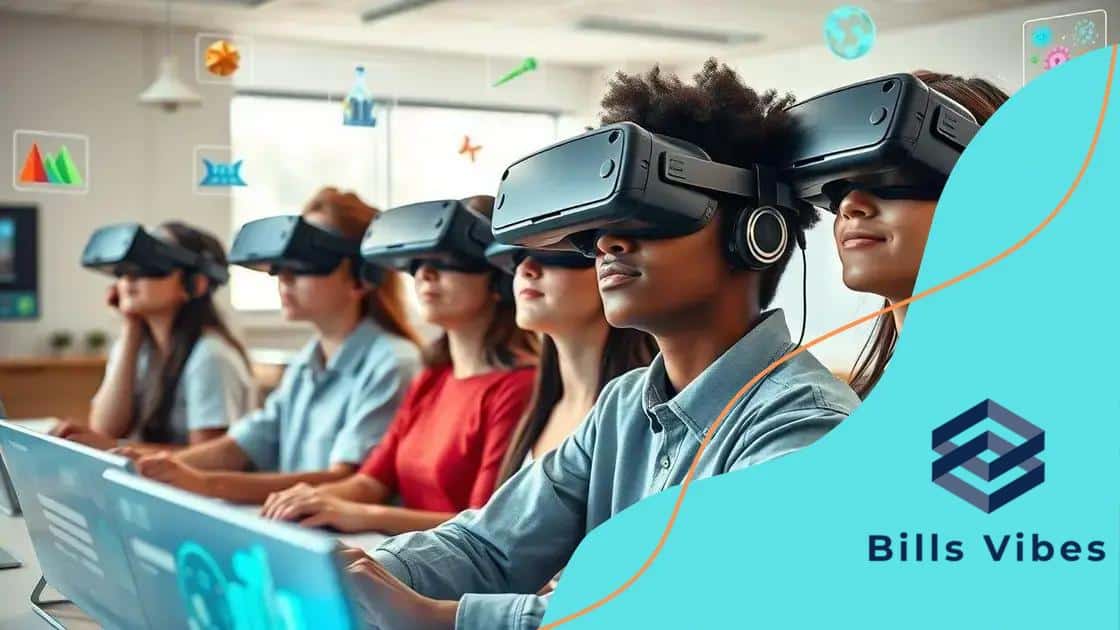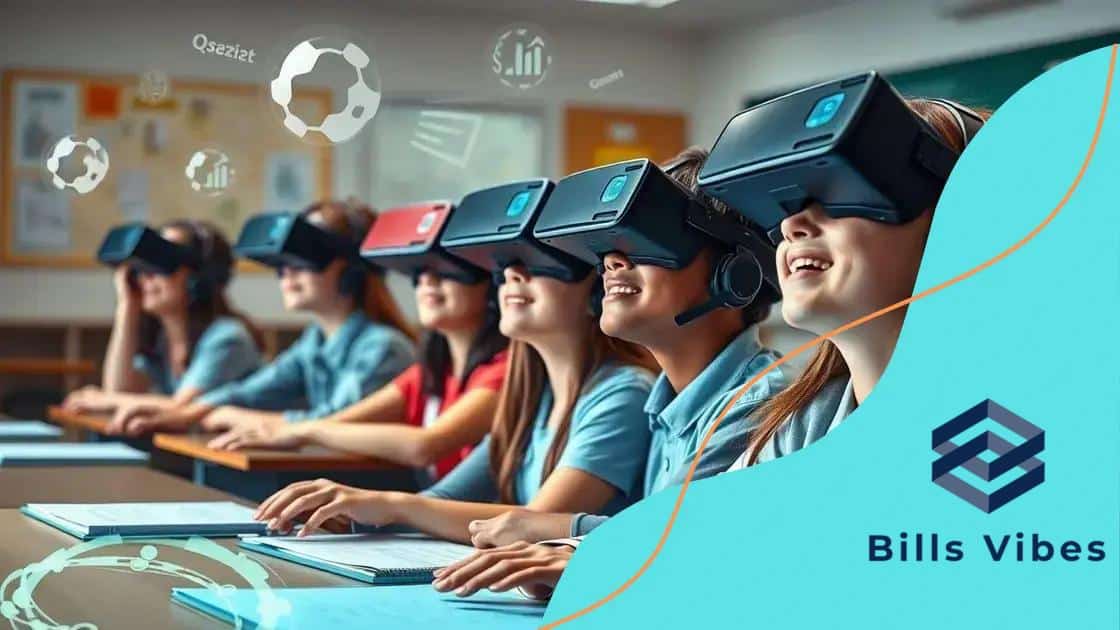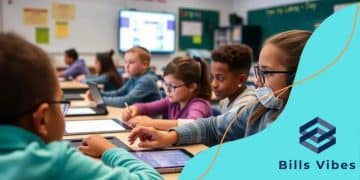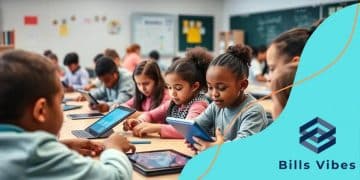VR in school education: a game changer for learning

VR in school education enhances student engagement by providing immersive learning experiences, allowing for interactive exploration of subjects like science and history while overcoming challenges such as cost and the need for teacher training.
VR in school education is opening up new dimensions for learning. Imagine students exploring ancient civilizations or diving into the ocean without leaving their classroom. Sounds fascinating, right?
Understanding VR technology in classrooms
When we talk about VR technology in classrooms, it’s essential to grasp how it reshapes the learning environment. Imagine students experiencing history as if they were there, or dissecting a frog in a virtual lab. This innovative approach not only engages students but also makes learning fun and immersive.
What is VR?
Virtual Reality (VR) creates a computer-generated environment that simulates real-life experiences. Through VR headsets, students can enter this immersive digital world, allowing them to see, hear, and sometimes even feel their surroundings.
Advantages of VR in Education
- Enhanced engagement: Students are more focused and motivated.
- Safe learning environment: Students can practice without real-world risks.
- Interactive experiences: Learning becomes hands-on and exploratory.
Furthermore, VR enables teachers to illustrate complex concepts through dynamic simulations. For example, scientific theories come alive as students observe molecular interactions in 3D. This type of learning sticks with students and helps them recall information during tests.
Moreover, this technology promotes collaboration among peers. Students can explore virtual field trips together, discussing findings and learning from each other. In a VR classroom, the social aspect of learning is amplified, creating a more connected and supportive educational experience.
Challenges of Using VR
While the benefits are clear, integrating VR technology in classrooms also has challenges. The cost of VR equipment can be high, and not all schools have the resources. Additionally, teachers require training to effectively utilize the technology. These hurdles need addressing to maximize the potential of VR in education.
Despite these challenges, the drive towards more engaging education continues. As technology advances and becomes more accessible, we can expect to see wider adoption of VR in school education. This exciting frontier promises a brighter future for learning, where every student can thrive in a world of possibilities.
Benefits of VR for student engagement
When considering the benefits of VR for student engagement, it’s vital to understand how this technology transforms classroom dynamics. Students, often distracted in traditional settings, become fully immersed in interactive lessons that capture their attention.
Active Participation
VR technology encourages active participation among students. Instead of passively listening, they engage with the content. Imagine them walking through ancient ruins or exploring the solar system. These experiences make learning more dynamic.
Enhanced Retention
Studies show that students remember information better when it is presented in an immersive format. By experiencing subjects firsthand, they can recall details with greater ease. For instance, a virtual science experiment allows students to see the results directly, solidifying their understanding.
- Real-world experiences enhance learning.
- Students connect emotionally with the material.
- Immersive learning leads to deeper insights.
Furthermore, VR in education fosters collaboration. Students can work together in virtual environments. This teamwork builds social skills and encourages diverse perspectives. Virtual field trips allow them to discuss their findings and experiences, making each lesson a shared adventure.
Additionally, students with different learning styles benefit immensely from VR. Visual learners can grasp concepts through vivid imagery, while kinesthetic learners can manipulate virtual objects. This personalized learning approach ensures everyone has the opportunity to engage with the material in ways that suit them best.
Motivation and Interest
Lastly, VR technology ignites curiosity. The very idea of exploring new worlds excites students. This motivation leads to increased interest in subjects they previously found dull. When students are eager to learn, they put in more effort, transforming their educational journey.
VR applications in various subjects

Exploring VR applications in various subjects opens a world of possibilities for educators and students alike. This innovative technology is making waves in several fields, enhancing how students learn and interact with content.
Science
In science classes, VR allows students to conduct experiments in a safe, virtual setting. For example, they can explore the human body in 3D, examining organs and systems without needing a physical specimen. This immersive experience deepens their understanding of complex concepts.
History
History lessons become captivating when students can explore ancient civilizations. Imagine walking through the streets of Rome or witnessing the signing of the Declaration of Independence. Such experiences foster a stronger connection to historical events, making them more relatable and impactful.
- Virtual time travel to significant historical events.
- Interactive explorations of ancient structures.
- Detailed visuals of historical artifacts.
Additionally, in geography classes, students can study different ecosystems and geographical formations around the world. With VR technology, they can visualize their study of landscapes, climates, and cultures in real-time. This type of learning enriches their education with global perspectives.
Mathematics
In mathematics, VR can visualize concepts that are often abstract. Students can explore geometric shapes in a 3D space, making it easier for them to grasp the complexities of the subject. This hands-on learning experience helps demystify challenging topics, boosting confidence.
Language arts also benefit from VR. Immersive storytelling experiences allow students to step into characters’ shoes, enhancing their understanding of narratives and themes. By interacting with the story, students can develop critical thinking and analytical skills.
The applications of VR in education are limitless. As technology advances, more subjects can embrace this transformative tool. The goal is to foster an engaging, interactive learning environment that caters to different learning styles.
Challenges of integrating VR in schools
Integrating VR technology in schools comes with its own set of challenges that educators must navigate. While the benefits are impressive, several barriers can impede effective implementation.
Cost of Equipment
One of the primary challenges is the high cost of VR equipment. Schools often operate under tight budgets, making it difficult to purchase multiple headsets and necessary technology. Investing in this technology requires careful planning and allocation of resources.
Training Educators
Another significant hurdle is ensuring that teachers are well-trained to use VR effectively. Many educators may feel intimidated by new technology or unsure about how to integrate it into their curricula. Providing ongoing training and support is essential for successful adoption.
- Developing comprehensive training programs.
- Offering workshops to improve technology skills.
- Creating a support network for teachers.
Additionally, not all students may have equal access to VR in their homes. This digital divide can lead to disparities in learning experiences. Schools must find ways to ensure that all students have an opportunity to benefit from VR technology.
Curriculum Development
Integrating VR into existing curricula requires thoughtful planning. Educators need to align virtual experiences with learning objectives. This process can be time-consuming and may demand new teaching strategies. Furthermore, adjusting the curriculum to include VR effectively can be challenging.
Another challenge is the potential for technical issues. VR systems may encounter glitches or require updates that can disrupt classroom activities. Establishing reliable technical support is crucial to minimize disruptions. Schools must be prepared for unexpected problems and have contingency plans in place to address them smoothly.
Despite these challenges, the potential rewards of adopting VR technology in education are significant. Overcoming these obstacles can lead to more engaging and effective learning environments.
Future of VR technology in education
The future of VR technology in education looks bright and full of potential. As advancements in technology continue to evolve, schools are finding new ways to integrate virtual reality into their teaching methods. This innovation promises to revolutionize how students learn, offering them immersive experiences that traditional classrooms simply cannot provide.
Expanding Accessibility
One exciting trend is the increasing accessibility of VR tools. As costs decrease, more schools will be able to afford VR equipment. This means that students from diverse backgrounds can experience the same interactive learning opportunities, leveling the educational playing field.
Personalized Learning Experiences
Another major development is the potential for personalized learning experiences. VR can adapt to individual student needs, allowing them to learn at their own pace. Tailored content can help students grasp challenging subjects, leading to better educational outcomes.
- Students can revisit challenging topics in VR.
- Adaptive environments can cater to various learning styles.
- Immediate feedback from virtual lessons enhances understanding.
In addition, schools are looking at ways to blend VR with other emerging technologies. For instance, combining VR with artificial intelligence can create smarter educational tools. These tools can analyze student performance and suggest improvements, fostering continuous growth in their learning journey.
Collaboration Beyond Borders
The future of VR also includes fostering collaboration between classrooms around the globe. Students can work together on projects in a virtual space, enhancing their teamwork skills. This global interaction encourages cultural appreciation and understanding.
Moreover, VR can facilitate virtual field trips that transport students to anywhere in the world. Imagine studying marine biology while swimming with dolphins in the ocean or exploring the pyramids in Egypt—all from the comfort of their classroom.
As educators embrace the possibilities of VR technology, we can expect even more innovative applications. The transformation in educational settings will lead to deeper engagement, broader horizons, and richer learning experiences for students everywhere.
FAQ – Frequently Asked Questions about VR in School Education
How does VR technology enhance student engagement?
VR technology increases student engagement by providing immersive and interactive learning experiences that capture their attention.
What subjects can benefit from VR applications?
Subjects like science, history, and mathematics can greatly benefit from VR applications by offering students hands-on experiences and visual learning opportunities.
What are some challenges of integrating VR in schools?
Challenges include high costs, the need for teacher training, and ensuring all students have equal access to VR technology.
What is the future potential of VR in education?
The future potential of VR in education includes personalized learning experiences, increased global collaboration, and the ability to adapt to various learning styles.






